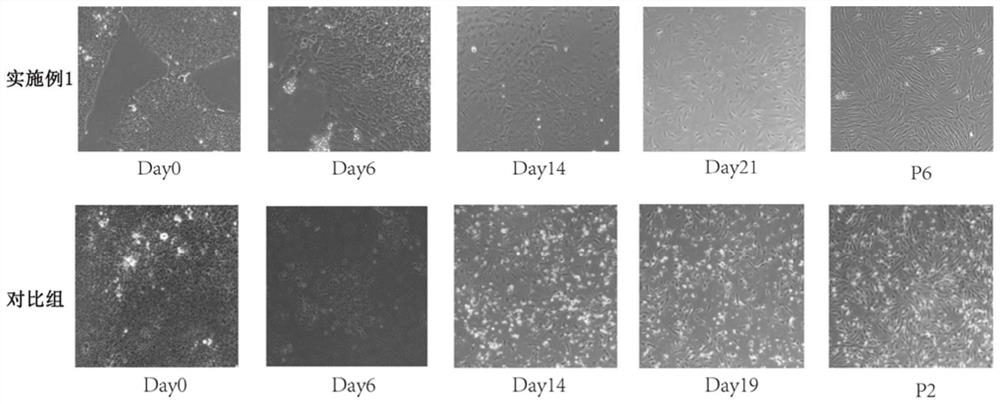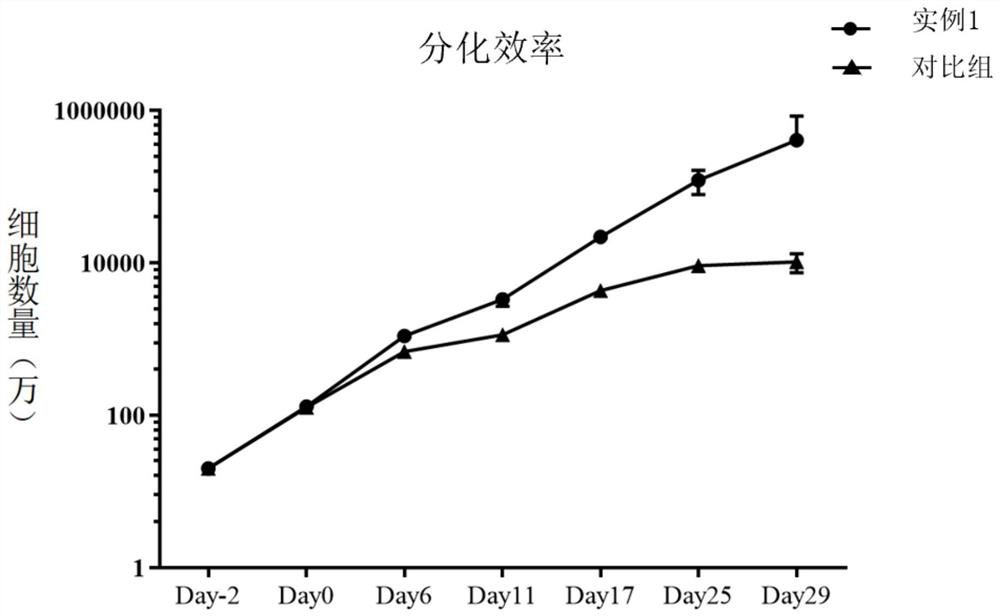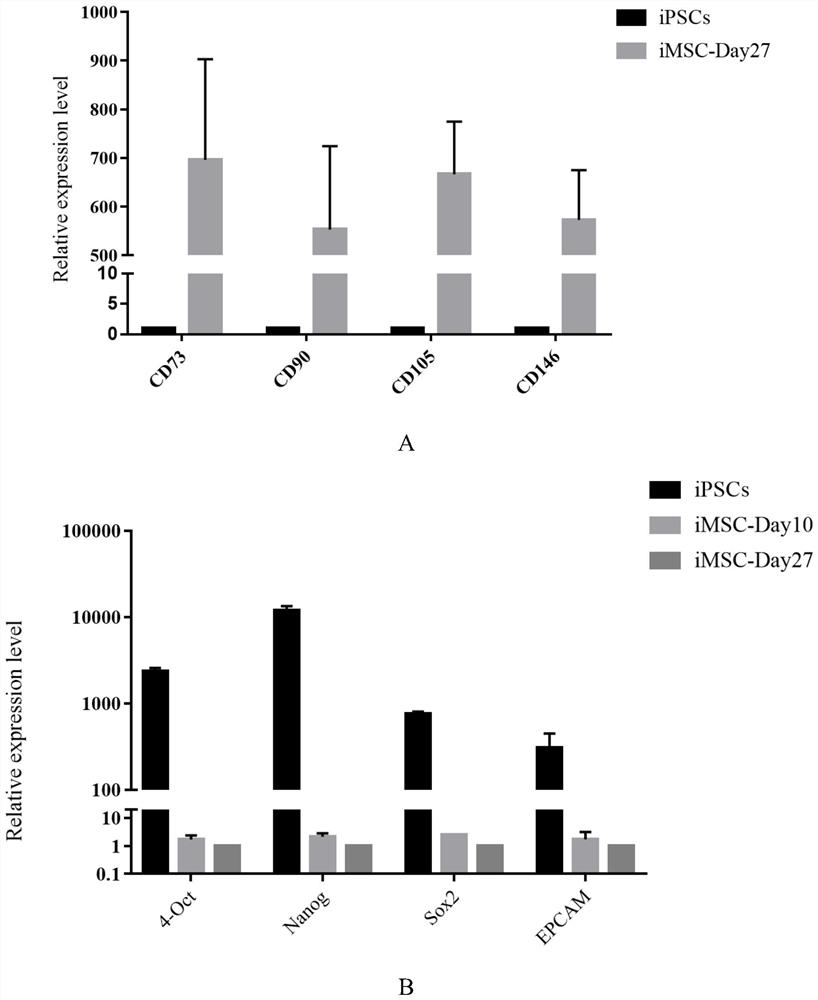A medium combination and method for inducing pluripotent stem cells to differentiate into mesenchymal stem cells
A technology of pluripotent stem cells and mesenchymal stem cells, which is applied in the field of medium combinations for inducing pluripotent stem cells to differentiate into mesenchymal stem cells, and can solve the problems of high cost, low efficiency, and instability of induced differentiation
- Summary
- Abstract
- Description
- Claims
- Application Information
AI Technical Summary
Problems solved by technology
Method used
Image
Examples
Embodiment 1
[0038]experiment one
[0039]1. Experimental materials: induce multidocarbon stem cells (IPSCs). (Cells from laboratory system-induced IPSCs, primitive cells from normal human cells)
[0040]2, experimental associated medium and reagents: mtessTM 1 (Stemcell, Cat # 85850), DMEM / F-12 (Gibco, Cat # 11320033), Accutase (InvitrogenTM , Cat # 00-4555-56), Y-27632 (Sigma, Cat # Y0503), Matrigel (BD, CAT # 356243), D-PBS (Gibco, Cat # C14190500Bt).
[0041]3, the experiment step:
[0042]In -2 days, preheat (15-25 ° C) sufficient IPSCS medium MTESRTM 1, DMEM / F-12 and pancreatic enzyme substitutes for passage. MTESRTM The Y-27632 was added to promote the IPSCS adhesion wall, and the final concentration of Y-27632 was 10 μmol / L.
[0043]The 1 ml Matrigel package was pre-6-well plates half an hour before the start of the experiment.
[0044]The pores were washed with 1 ml D-PBS (excluding Ca ++ and Mg ++). Wash discard.
[0045]Add 1 ml Accutase to digest the IPSCs.
[0046]It was incubated at 37 ° C for 3 to ...
Embodiment 2
[0101]1. Objective: human mixed stem cell fluorescence quantitative PCR identification.
[0102]2. Experimental materials: mesenchymal stem cells divided by IPSCs and Example 1 (DAY represents the number of days from induction).
[0103]3, the experiment step:
[0104](1) Sample RNA extraction.
[0105](2) RNA concentration and quality assay.
[0106](3) Sample CDNA synthesis, synthesized cDNA in accordance with the reverse transcription standard system.
[0107](4) Dilute the sample template and follow the QPCR standard system. Each sample was repeated three times.
[0108](5) The relative expression of the gene of the calculated purpose.
[0109]OCT, Naong, SOX2, and EPCAM are embryonic stem cell-specific markers, while CD73, CD90, CD105, and CD 146 are markers of mesenchymal stem cell specificity. The fluorescent quantitative PCR results can be seen from the high expression specific marker of differentiated mature mesenchymal stem cells, while low expression of embryonic stem cell surface label. Descrip...
Embodiment 3
[0112]1. Objective: Human mixed stem cell immunofluorescence staining identification.
[0113]2. Experimental materials: Methylactic stem cells (DAY27) were completed in Example 1.
[0114]3, the experiment step:
[0115]The cell climbing in the 24-well plate was added, and the package was gelatin, 37 ° C 2 h.
[0116]Wrap the mesenchymal stem cells onto climbs, 37 ° C, 5% CO2Infit 1 to 2 days.
[0117]Abandon the culture medium, washed 1 free with PBS, 5 min every time.
[0118]Add 4% formaldehyde, 500 μl per well, and fixed at room temperature for 15 min.
[0119]Wash 3 times with PBS, 3 minutes per night, 30 rpm shake.
[0120]0.2% Triton-X100 room temperature is 15 min, 500 μL per well.
[0121]Wash 3 times with PBS, 3 minutes per night, 30 rpm shake.
[0122]3% BSA room temperature is closed for 1 to 2 hours, 500 μL per well.
[0123]Plus a anti-CD73 (Abcam, Cat # AB133582) 4 ° C overnight: antibody was diluted with 3% BSA, and 40 to 50 μl can be used according to each climb. The rubber strip is fixed to the d...
PUM
 Login to View More
Login to View More Abstract
Description
Claims
Application Information
 Login to View More
Login to View More - Generate Ideas
- Intellectual Property
- Life Sciences
- Materials
- Tech Scout
- Unparalleled Data Quality
- Higher Quality Content
- 60% Fewer Hallucinations
Browse by: Latest US Patents, China's latest patents, Technical Efficacy Thesaurus, Application Domain, Technology Topic, Popular Technical Reports.
© 2025 PatSnap. All rights reserved.Legal|Privacy policy|Modern Slavery Act Transparency Statement|Sitemap|About US| Contact US: help@patsnap.com



